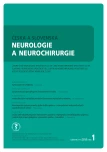Protocol of Diagnostic and Treatment of Hyponatremia and Hypernatremia in Neurocritical Care
Authors:
V. Špatenková 1; P. Škrabálek 2
Authors‘ workplace:
Krajská nemocnice Liberec, a. s.
Neurocentrum, Neurointenzivní jednotka
1; Krajská nemocnice Liberec, a. s.
Oddělení klinické biochemie
2
Published in:
Cesk Slov Neurol N 2015; 78/111(1): 34-37
Category:
Review Article
Overview
Dysnatremias are common and serious complications in neurocritical care. They pose a risk mainly due to their effect on osmolality of extracellular fluids that influences the amount of water in intracellular fluids. Hyponatremia is associated with a risk of brain edema, while hypernatremia can cause brain dehydration. Hyponatremia occurs more frequently but hypernatremia is associated with poorer prognosis, serum sodium above 160 mmol/l is an independent risk factor for higher mortality. Risk factors for dysnatremias include: 1. brain damage, 2. therapeutic processes during neurocritical care, 3. iatrogenic conditions. One of the aims of neurocritical care is to prevent iatrogenic hypo/hypernatremias.
Key words:
hyponatremia – hypernatremia – neurocritical care
The authors declare they have no potential conflicts of interest concerning drugs, products, or services used in the study.
The Editorial Board declares that the manuscript met the ICMJE “uniform requirements” for biomedical papers.
Sources
1. Funk GC, Lindner G, Druml W, Metnitz B, Shwarz CH, Bauer P et al. Incidence and prognosis of dysnatremias present on ICU admission. Intensive Care Med 2010; 36(2): 304 – 311. doi: 10.1007/ s00134 ‑ 009 ‑ 1692 ‑ 0.
2. Peters JP, Welt LG, Sims EA, Orloff J, Needham J. A salt ‑ wasting syndrome associated with cerebral disease. Trans Assoc Am Physicians 1950; 63 : 57 – 64.
3. Schwartz WB, Bennett W, Curelop S, Bartter FC. A syndrome of renal sodium loss and hyponatremia probably resulting from inappropriate secretion of antidiuretic hormone. Am J Med 1957; 23(4): 529 – 542.
4. Shoker AS. Application of the clearance concept to hyponatremic and hypernatremic disorders: a phenomenological analysis. Clin Chem 1994; 40(7): 1220 – 1227.
5. Aiyagari V, Deibert E, Diringer M. Hypernatremia in the neurologic intensive care unit: how high is too high? J Crit Care 2006; 21(2): 163 – 172.
6. Wong MF, Chin NM, Lew TW. Diabetes insipidus in neurosurgical patients. Ann Acad Med Singapore 1998; 27(3): 340 – 343.
7. Spatenkova V, Bradac O, Kazda A, Suchomel P. Central diabetes insipidus is not a common and prognostically worse type of hypernatremia in neurointensive care. Neuro Endocrinol Lett 2011; 32(6): 879 – 884.
8. Spasovski G, Vanholder R, Allolio B, Annane D, Ball S, Bichet D et al. Clinical practice guideline on diagnosis and treatment of hyponatraemia. Eur J Endocrinol 2014; 171(1): G1 – G47. doi: 10.1530/ EJE ‑ 13 ‑ 1020.
9. Spatenkova V, Bradac O, Skrabalek P. Outcome and frequency of sodium disturbances in neurocritically ill patients. Acta Neurol Belg 2013; 113(2): 139 – 145. doi: 10.1007/ s13760 ‑ 012 ‑ 0137 ‑ 7.
10. Tisdall M, Crocker M, Watkiss J, Smith M. Disturbances of sodium in critically ill adult neurologic patients: a clinical review. J Neurosurg Anesthesiol 2006; 18(1): 57 – 63.
11. Špatenkova V, Kazda A, Barsa P, Beneš V III, Škrabálek P, Králová D et al. Diagnostika hyponatrémií v neurointenzivní péči: úloha renálních funkčních parametrů. Cesk Slov Neurol N 2008; 71/ 104(2): 156 – 162.
Labels
Paediatric neurology Neurosurgery NeurologyArticle was published in
Czech and Slovak Neurology and Neurosurgery

2015 Issue 1
Most read in this issue
- Protocol of Diagnostic and Treatment of Hyponatremia and Hypernatremia in Neurocritical Care
- Mini‑Mental State Examination – Czech Normative Study
- Autoimmune Encephalitis
- Asymptomatic Spondylotic Cervical Cord Compression
